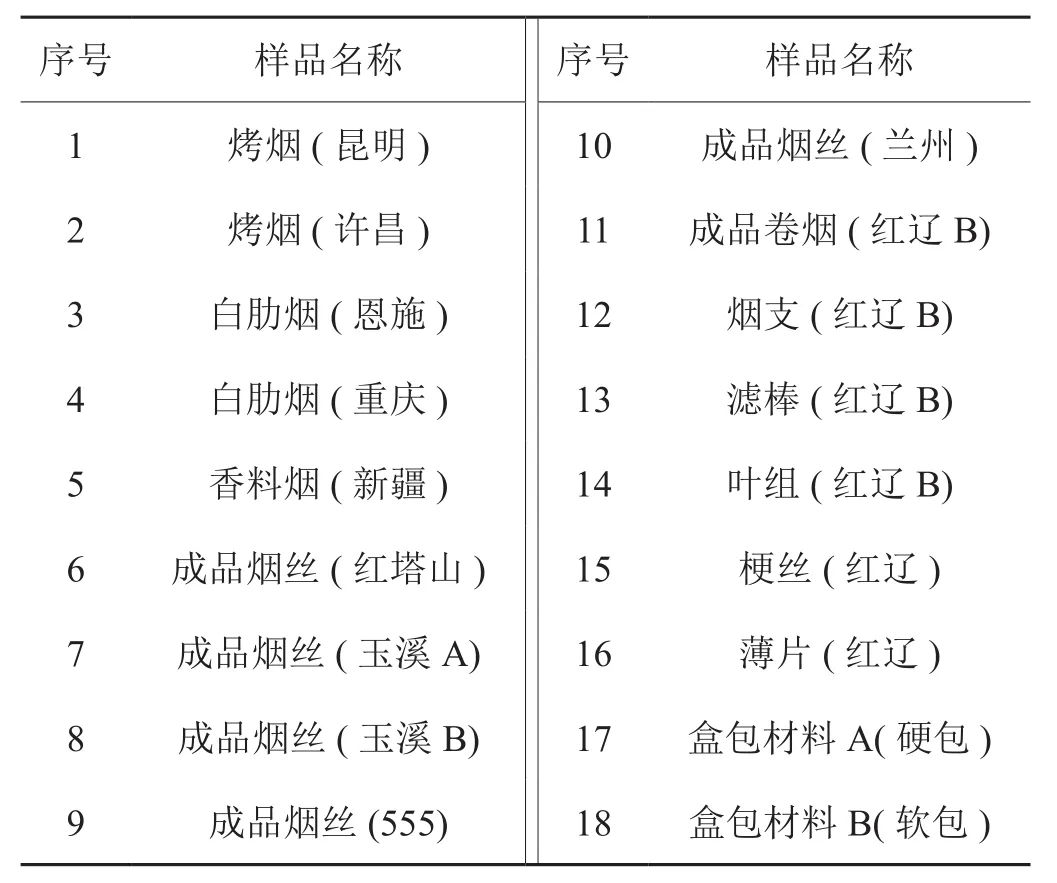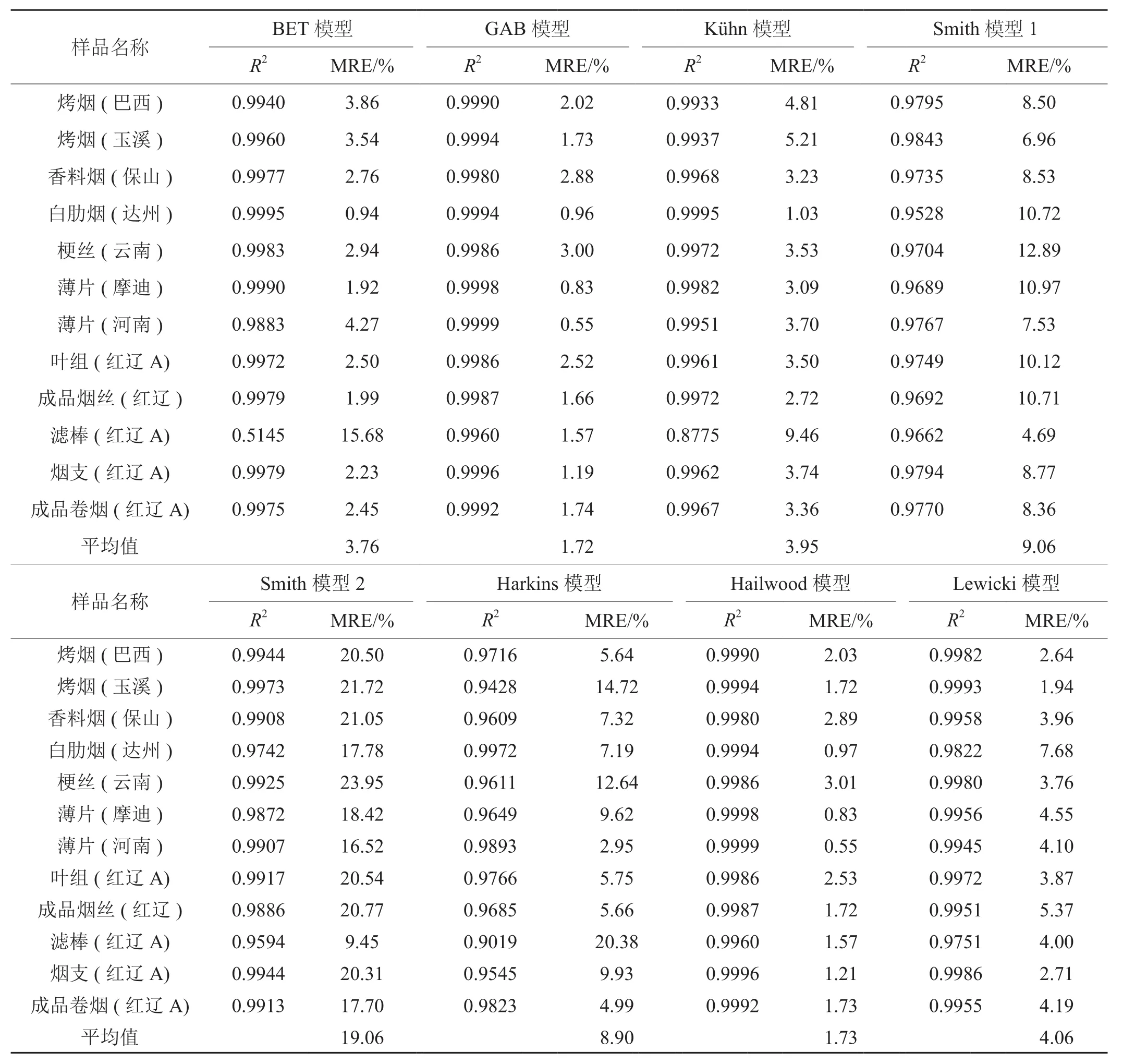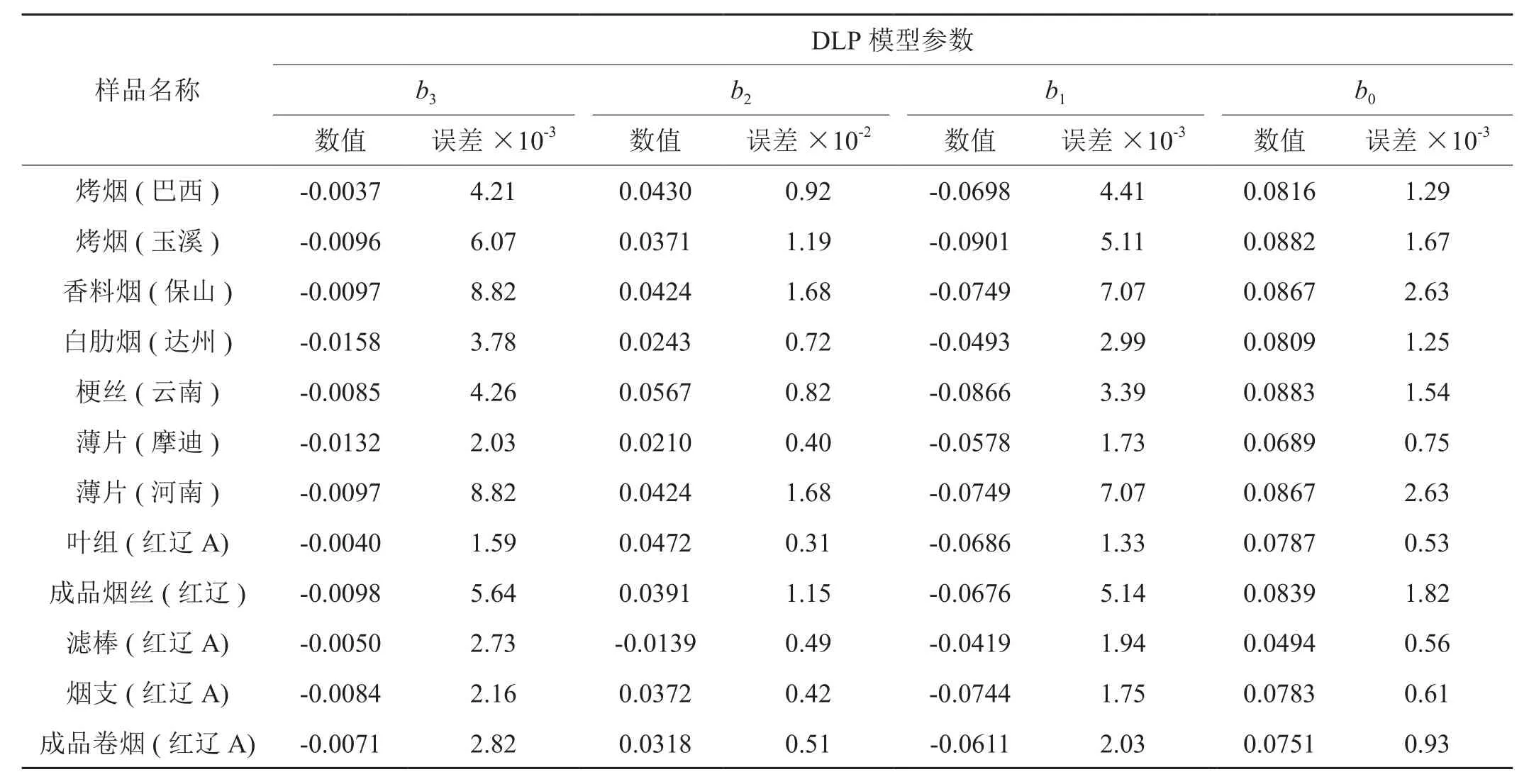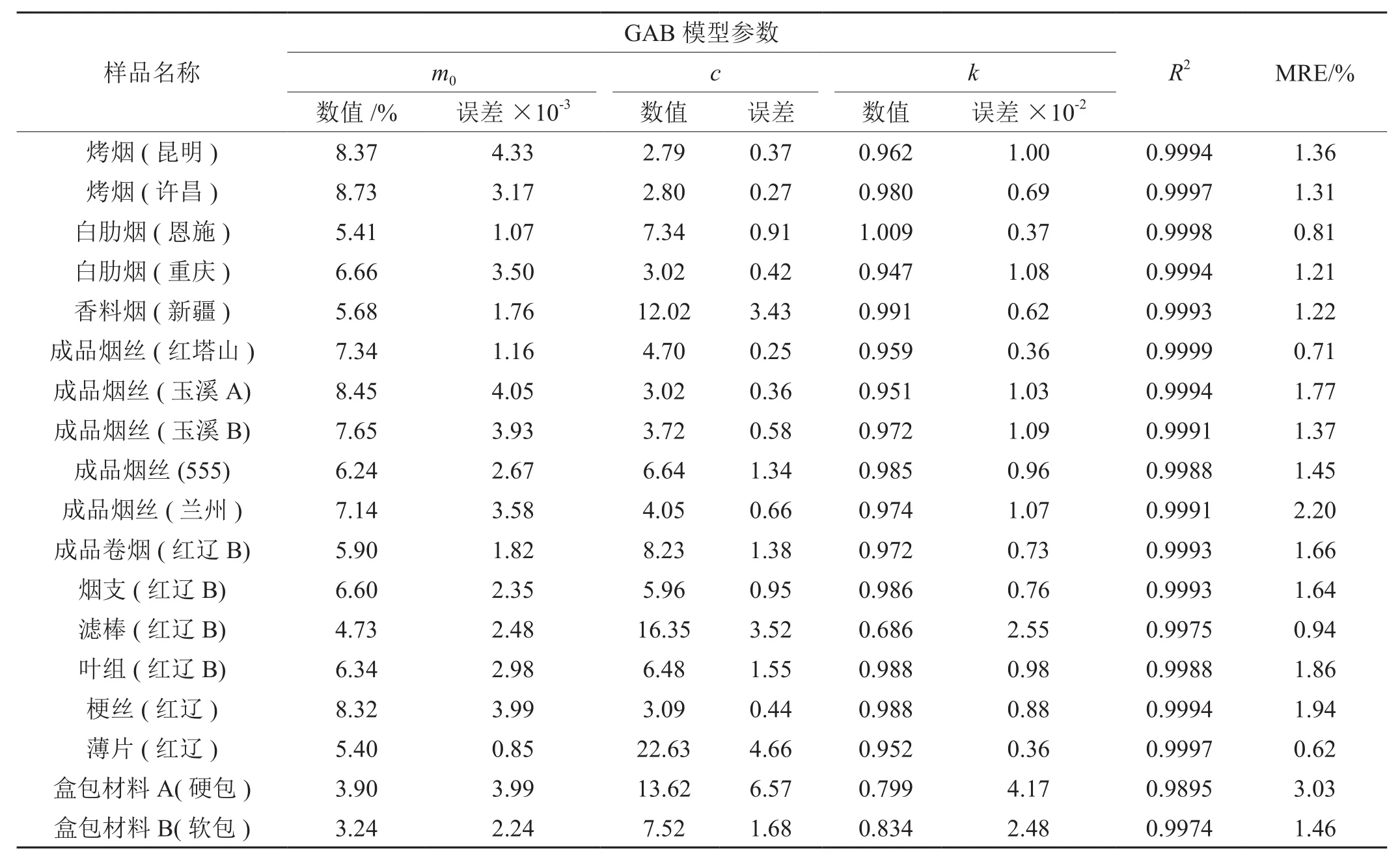烟草样品等温吸湿模型的比较与分析
2017-11-16迟广俊郭鹏洪广峰霍现宽邱宝平刘晓旭马骥赵明月崔凯
迟广俊,郭鹏,洪广峰,霍现宽,邱宝平,刘晓旭,马骥,赵明月,崔凯
1 红塔辽宁烟草有限责任公司技术中心,沈阳市和平区和平北大街26号110001;2 中国烟草总公司郑州烟草研究院,郑州市高新区枫杨街2号450001
烟草样品等温吸湿模型的比较与分析
迟广俊1,郭鹏1,洪广峰2,霍现宽2,邱宝平1,刘晓旭1,马骥2,赵明月2,崔凯2
1 红塔辽宁烟草有限责任公司技术中心,沈阳市和平区和平北大街26号110001;2 中国烟草总公司郑州烟草研究院,郑州市高新区枫杨街2号450001
为了筛选出适合不同烟草样品的等温吸湿模型,从食品等温吸湿研究领域的众多模型中选择了14种常用的数学模型,包括理论模型8种:BET模型、GAB模型、Kühn模型、Smith模型1(非溶胀材料)、Smith模型2(溶胀材料)、Harkins模型、Hailwood模型和Lewicki模型,经验/半经验模型6种:Peleg模型、Ferro Fontan模型、DLP模型、Konstance模型、Oswin模型和Polynomial模型,对12个不同类型烟草样品的实验数据进行拟合,通过决定系数(R2)和平均相对误差(MRE)对模型的拟合效果进行了评价,并用18个不同类型的烟草样品对优选模型进行了验证。结果表明,GAB和DLP模型具有较好的普遍适用性,可分别作为烟草样品等温吸湿研究领域的理论模型和经验/半经验模型进行推广应用。
烟草;等温吸湿模型;决定系数;平均相对误差;GAB;DLP
烟草是一种胶体毛细管多孔薄层物料,具有很强的吸湿和解湿能力[1]。烟草含水率及水分的稳定性,是影响卷烟感官品质[2]、生产加工过程[3-4]以及烟气有害成分[5]的重要因素。等温吸湿曲线描述了在恒定温度和压力下、样品平衡含水率与水活度之间的热力学关系,在样品的质量稳定性预测及水分变化计算等方面具有重要的应用价值[6-7]。近年来,食品行业在等温吸湿曲线方面开展了大量的研究,并对不同类型食品所适合的等温吸湿模型进行了对比与筛选[8-20]。烟草行业在平衡含水率及等温吸湿曲线等方面也开展了一定的实验拟合[21-22]和模型筛选[23-26]研究,但所涉及的样品种类一般为1~3种,所选择模型一般为1~5个,在样品种类及等温吸湿模型的选择方面缺乏系统性研究。因此,综合筛选了14种食品及烟草行业常用的等温吸湿模型,对其在不同类型叶丝、梗丝、再造烟叶(薄片)、叶组、成品烟丝和成品卷烟等不同烟草样品中的适用情况进行比较,并用不同烟草样品(单料烟丝和成品卷烟烟丝)对优选模型进行验证,旨在为烟草样品的保润研究提供合适的等温吸湿模型,为提高烟草样品的保润性能提供参考。
1 材料与方法
1.1 材料与仪器
12个模型筛选烟草样品和18个模型验证烟草样品由郑州烟草研究院与红塔辽宁烟草有限责任公司收集,样品信息分别见表1表2。

表1 12个模型筛选烟草样品信息Tab.1 Informations of 12 tobacco samples for model screening

表2 18个模型验证烟草样品信息Tab.2 Informations of 18 tobacco samples for model validation
CPA225D电子天平(感量:0.00001g,德国赛多利斯公司)、AquaLab 4TE水活度仪(美国DECAGON公司)、101-0型鼓风干燥箱(上海圣欣科学仪器有限公司)、QS-2A型实验切丝机(郑州嘉德机电科技有限公司)。
1.2 方法
1.2.1 等温吸湿曲线的绘制
将样品(约5 g)分别置于相对湿度约为20%、30%、40%、50%、60%、70%、80%,温度(22±1)℃的硫酸干燥器中,平衡10 d,然后取出样品使用水活度计测定其水活度,每个湿度条件3个平行样,取平均值;同时,按YC/T 31—1996《烟草及烟草制品含水率的测定》的方法检测其含水率,每个湿度条件3个平行样,取平均值。分别以湿度条件(含水率m)和对应的水活度(aw,0.2~0.8)为横坐标和纵坐标,绘制样品的等温吸湿曲线。
1.2.2 等温吸湿模型的选择
参考食品[8-20]及烟草[23-26]行业的等温吸湿模型研究现状,综合筛选出14种常用的等温吸湿模型(理论模型、经验/半经验模型),如表3所示。

表3 14种常用的等温吸湿模型①Tab.3 14 commonly used models of isothermal moisture absorption

续表3
1.2.3 等温吸湿模型的拟合方法及拟合效果评价
(1)模型的拟合方法
利用Origin8.5软件编写14种等温吸湿模型方程,并参考相关文献[8-9]设定各等温吸湿模型方程拟合的初始参数值,对实验数据进行非线性拟合。
(2)拟合效果的评价
通过决定系数(R2)和平均相对误差[MRE,mean relative error(mean relative percent deviation)]评价模型的拟合效果。其中:

式中:SSE—残差平方和;SST—总平方和。
R2表示实验数据与模型函数之间的曲线拟合程度,其数值越接近1,表明曲线的拟合效果越好[6,15]。

式中:n—绘制等温吸湿曲线时的样品个数;me—含水率实验值,% ;mp—含水率的模型预测值,%。
MRE表示实验数据与模型函数之间数据接近程度,MRE的数值小于10%,表明该模型具有较好的适用性;MRE的数值小于5%,表明该模型具有优良的适用性;MRE的数值越小,表明该模型拟合的越好[6,27-28]。
2 结果与讨论
2.1 等温吸湿模型的选择依据及评价指标
在选择适合样品的等温吸湿模型时,需要考虑模型的准确性、模型各参数所代表的物理学意义[29]。理论模型一般是基于对吸附过程的各种假设,如发生在均一表面上的单层吸附(BET模型)或多层吸附(GAB模型);发生在非均一性表面的吸附(Hailwood模型)、发生在毛细管中的冷凝吸附(Kühn模型)、发生在凝胶中的局部吸附(Smith模型1、Smith模型2),或基于吉布斯表面吸附、拉乌尔定律(Raoult’s Law)的Harkins-Jura模型、Lewicki模型,模型中的参数代表着相应的物理学意义。经验/半经验模型通常是基于实验数据对等温吸湿曲线的回归模型(Peleg、Konstance,Oswin、Polynomial)或模型参数形式(DLP)进行优化,以提高模型拟合的准确性。模型的准确性一般通过决定系数(R2)、平均相对误差(MRE)等指标进行评价。本研究中,以决定系数(R2)和平均相对误差(MRE)为指标,对14种等温吸湿模型在12个烟草样品上的拟合效果进行了评价。
2.2 8种理论模型对筛选烟草样品的拟合结果
从R2的数值(表4)判断,BET模型和Kühn模型在滤棒(红辽)样品中的R2值小于0.9,曲线拟合效果相对较差。其中,BET模型主要适用于低水活度范围(aw<0.45)内的单分子层水含量计算[6,9,18],不适用于广泛相对湿度范围内的等温吸湿模型拟合。

表4 8种等温吸湿理论模型对12个烟草样品的拟合效果Tab.4 Fitted results of 12 tobacco samples by using eight theoretical models of isothermal moisture absorption
通过分析表4中8种等温吸湿理论模型的MRE值可知,BET模型、Smith模型1、Smith模型2与Harkins模型4个模型的最大MRE值均大于10%,模型拟合效果较差;Kühn模型与Lewicki模型的最大MRE值处于5%~10%之间,可以用于烟草样品的等温吸湿模型拟合;GAB模型与Hailwood模型的最大MRE值均在3%左右,平均MRE值均在1.7%左右,能够较好地应用于烟草样品的等温吸湿模型拟合。

GAB模型的转换式:Hailwood模型(表3)与公式(3)相比,仅存在模型常数方面的差异。目前,GAB模型已在国内外得到广泛的推广应用[6,17-18,26,28],且模型中单分子层水含量m0常数的存在有利于进一步深入研究烟草样品的持水能力。
2.3 6种经验/半经验模型对筛选烟草样品的拟合结果
从R2的数值(表5)判断,6种等温吸湿经验/半经验模型的R2均大于0.9,曲线拟合效果相对较好。

表5 6种等温吸湿经验/半经验模型对12个烟草样品的拟合效果Tab.5 Fitted results of 12 tobacco samples by using six empirical/semi-empirical models of isothermal moisture absorption
通过分析表5中6种等温吸湿经验/半经验模型的MRE值可知,Konstance模型的最大MRE值大于10%,模型拟合效果较差;Oswin模型的最大MRE值处于5%~10%之间,可以用于烟草样品的等温吸湿模型拟合;Peleg模型、Ferro Fontan模型、DLP模型和Polynomial模型4个模型最大MRE值均小于5%,均能够很好地应用于烟草样品的等温吸湿模型拟合。其中,DLP模型的MRE平均值和最大值均最小,因此更适合作为烟草样品等温吸湿研究领域的经验/半经验模型进行推广应用。
2.4 GAB和DLP等温吸湿模型的验证
由表4和表5中的R2值和MRE值可知,理论模型中的GAB模型和经验/半经验模型中的DLP模型对12个模型筛选样品均具有较好的拟合效果,模型参数分别如表6和表7所示。

表6 12个模型筛选烟草样品的GAB模型参数Tab.6 GAB model parameters of 12 tobacco samples for model screening

表7 12个模型筛选烟草样品的DLP模型参数Tab.7 DLP model parameters of 12 tobacco samples for model screening
采用18个不同类型和产地以及不同加工过程中的烟草样品对GAB和DLP模型进行了验证,结果分别见表8和表9。可以看出,GAB模型拟合结果R2均大于0.999,最大MRE值为2.20%;DLP模型拟合结果R2均大于0.998,最大MRE值为1.89%。说明GAB和DLP模型具有良好的普适性。因此,在烟草样品等温吸湿研究领域,GAB和DLP模型可分别作为理论模型和经验/半经验模型进行推广应用。

表8 18个模型验证烟草样品的GAB模型拟合效果Tab.8 Fitted results of 18 kinds of tobacco samples for model validation by GAB model

表9 18个烟草样品的DLP模型拟合效果Tab.9 Fitted results of 18 kinds of tobacco samples by DLP model
由于理论模型GAB模型在BET模型的基础上增加了一个校正多层吸附水结合能力差异的参数k,因而具有更好的通用性。Lewick[30]研究发现,c和k两个参数的值需要保持在一定范围内(5.67≤c<∞,0.24<k≤1.00),当超出范围时,样品的等温吸湿曲线可能不再呈S型或参数m0的拟合误差会超过15.5%;当k值大于1.00时,各参数可能会失去原来所代表的物理学意义。
从表6和表8可以看出,部分烟草样品的c值小于5.67,而其k值均小于1.00,说明这些样品的等温吸湿曲线在水活度0.2~0.8范围内不是S型曲线,而是J型曲线。m0的拟合误差主要分布在2%~6%;k的拟合误差主要分布在1%左右;而c的拟合误差则主要分布在10%~30%。Timmermann等[31]报道m0的拟合误差约在4%~8%、k的拟合误差约在10%~15%,而c的拟合误差一般较大,约在15%~70%。m0反映最高稳定性时的含水率,当样品含水率高于m0时,在贮藏过程中更容易发生腐败或霉变。薄片、白肋烟样品的m0值较烤烟、香料烟、梗丝等样品的m0值低;成品烟丝(555)的m0值比国产烤烟型卷烟烟丝的m0值低。GAB模型中k值的高低反映多层吸附水(单分子层外的吸附水)结合能力的差异,当k值较低时,表明样品在单分子层外吸附层中的结合能力较低[32]。两个滤棒样品的k值分别为0.50和0.69;两个盒包材料的k值分别为0.80和0.83;而其他样品的k值均高于0.95。表明不同类型样品对水分的吸附方式存在较大的差异。
图1为4个样品的实验值与GAB模型拟合值的对比图。可以看出,对于成品烟丝(红辽)、薄片(河南)、滤棒(红辽B)和盒包材料A(硬包)4种样品,在低水活度(aw<0.40)时,曲线从上到下的顺序与m0值的大小顺序一致(烟丝、薄片、滤棒和盒包材料的m0值分别为6.77%、5.51%、4.73%和3.90%);在高水活度(aw>0.75)时,曲线从上到下的顺序与k值的大小顺序基本一致(烟丝、薄片、滤棒和盒包材料的k值分别为0.982、0.955、0.799和0.686)。
经验模型主要是为了精确描绘样品的等温吸湿过程而建立的回归模型,所建立的模型可为样品含水率/水活度的预测[33]、烟草包装保存期预测数学模型的研究[34-35]提供分析工具。通常,在建立经验模型时,并不探究模型参数的具体意义。DLP等温吸湿模型是一种经验模型[36],本课题组已将该模型用于配方烟草样品等温吸湿曲线的预测[33]以及卷烟物理保润性能的分析与研究[37],并得到了较好的应用效果。

图1 4个烟草样品实验值与GAB模型拟合值的对比Fig.1 Comparison of experimental and fi tted values of four tobacco samples by GAB model
3 结论
通过对14种等温吸湿模型在12个烟草样品中的拟合效果比较与分析,确定GAB和DLP两个模型在不同类型的烟草样品中均有较好的拟合效果。选择18个不同烟草样品对优选的两个模型进行了验证,均得到较好的拟合结果。GAB和DLP模型可在烟草样品等温吸湿研究领域分别作为理论模型和经验/半经验模型推广应用。
[1] 李善莲, 王宏生, 袁行思. 烟草干燥研究进展[J]. 烟草科技, 2004(9): 6-9,15.LI Shanlian, WANG Hongsheng, YUAN Xingsi. Advance in tobacco drying[J]. Tobacco Science & Technology,2004(9): 6-9,15.
[2] 孙雯, 李雪梅, 曾晓鹰, 等. 烟丝含水率对卷烟燃吸品质、烟气水分及粒相物挥发性成分的影响[J]. 烟草科技,2009(11): 33-39.SUN Wen, LI Xuemei, ZENG Xiaoying, et al. Influence of moisture content in cut tobacco on smoking quality,particulate volatile components and moisture content in cigarette smoke[J]. Tobacco Science& Technology,2009(11): 33-39.
[3] 席年生, 赵兵, 李明哲, 等. 烟丝含水率—影响卷制质量的一个重要因素[J]. 烟草科技, 2001(7): 8-9.XI Niansheng, ZHAO Bing, LI Mingzhe, et al. Effect of the moisture of cut tobacco on cigarette making quality[J].Tobacco Science& Technology, 2001(7): 8-9.
[4] 寇伟, 马林, 王建民, 等. 卷烟的卷制水分变化对卷制质量的影响[J]. 郑州轻工业学院学报(自然科学版), 2000,15(4): 130-133.KOU Wei, MA Lin, WANG Jianmin, et al. Analysis of the e ff ects on moisture wave for cigarette making on cigarette quality[J]. Journal of Zhengzhou Institute of Light Industry(Natural Science), 2000, 15(4): 130-133.
[5] 刘志华, 杨松, 王昆淼, 等. 烟丝含水率对主流烟气CO等7种有害成分释放量的影响[J]. 烟草科技, 2012(1):29-33.LIU Zhihua, YANG Song, WANG Kunmiao, et al. E ff ects of moisture content in cut tobacco on deliveries of 7 harmful compounds in mainstream cigarette smoke[J].Tobacco Science& Technology, 2012(1): 29-33.
[6]Andrade P R D, Lemus M R, Pérez C C E. Models of sorption isotherms for food: uses and limitations[J]. Vitae Revista de la Facultad de Quimica, 2011, 18(3): 325-334.
[7]Raji A O, Ojediran J O. Moisture sorption isotherms of two varieties of millet[J]. Food and BioproductsProcessing,2011, 89(3):178-184.
[8]Labuza T P, Labuza A. Water activity prediction and moisture sorption isotherms, water activity in foods:Fundamentals and applications[M]. Oxford: Wiley-Blackwell, 2008.
[9]Rahman M S. Food properties handbook[M]. 2nd ed. Boca Raton: CRC Press Inc, 2008.
[10]Nurtama B, Lin J. Moisture sorption isotherm characteristics of taro fl our[J]. World Journal of Dairy & Food Sciences,2010, 5(1): 1-6.
[11]McMinn W A. M, McKee D J, Magee T R A. Moisture adsorption behavior of oatmeal biscuit and oat flakes[J].Journal of Food Engineering, 2007, 79(2):481-493.
[12]Konstance R P, Craig J C Jr, Panzer C C. Moisture sorption isotherms for bacon slices[J]. Journal of Food Science,1983, 48(1): 127-130.
[13]Alakali J S, Irtwange S V, Agbali F A. Physicothermodynamic properties of soy-gari[J]. Journal of Food Processing and Preservation, 2010, 34(Suppl 2): 470-489.
[14]金花. 稻谷吸附与解吸等温线计算模型及模拟研究[D].保定: 河北农业大学, 2011.JIN Hua. The study on computing model and simulation of the adsorption and desorption isotherms of rice[D].Baoding: Agricultural University of Hebei, 2011.
[15] 刘成梅, 周国辉, 万婕, 等. 大米淀粉解吸等温线与吸附等温线的拟合模型研究[J]. 食品工业科技, 2014, 35(10):198-201.LIU Chengmei, ZHOU Guohui, WAN Jie, et al. Study on the model fitting of moisture desorption isotherm and absorption isotherm of rice starch[J]. Science and Technology of Food Industry, 2014, 35(10): 198-201.
[16] 李兴军, 王双林, 张元娣, 等. 玉米吸湿特性及其等温线类型研究[J]. 中国粮油学报, 2012, 27(1): 80-86,96.LI Xingjun, WANG Shuanglin, ZHANG Yuandi, et al. The hygroscopic properties and sorption isotherm classi fi cation of sixteen Chinese shelled-corn varieties[J]. Journal of the Chinese Cereals and Oils Association, 2012, 27(1): 80-86,96.
[17] 马晓燕, 崔思寒, 阿里木江, 等. 方便面等温吸湿规律的研究[J]. 食品工业, 2013, 34(7): 84-87.MA Xiaoyan, CUI Sihan, A Limujiang, et al. Study on sorption isotherms of instant noodle[J]. The Food Industry,2013, 34(7): 84-87.
[18] 王高杰, 刘妍, 曹思远, 等. 曲奇饼干等温吸湿规律及模型研究[J]. 食品科技, 2012, 37(12): 63-66.WANG Gaojie, LIU Yan, CAO Siyuan, et al. Moisture sorption isotherm characteristics andmodel characterization of cookie biscuit[J]. Food Science and Technology, 2012,37(12): 63-66.
[19]雷茜, 范柳萍. 油炸香蕉片的等温吸湿规律及其热力学研究[J]. 食品工业科技, 2013, 34(23): 49-52, 57.LEI Xi, FAN Liuping. Sorption isotherms and thermodynamic properties of fried banana chips[J]. Science and Technology of Food Industry, 2013, 34(23): 49-52, 57.
[20] 杨爱金, 毕金峰, 刘璇, 等. 变温压差膨化苹果脆片等温吸湿规律研究[J]. 食品科技, 2013, 38(5): 116-120.YANG Aijin, BI Jinfeng, LIU Xuan, et al. The investigation on sorption isotherms of explosion puffing drying apple chips[J]. Food Science and Technology, 2013, 38(5): 116-120.
[21] 胡有持, 徐亮, 张威, 等. 云南烤烟的吸湿特性研究[J].烟草科技, 2000(9): 8-12.HU Youchi, XU Liang, ZHANG Wei, et al. Study on the hydroscopic characteristics of flue-cured tobacco from Yunnan[J]. Tobacco Science& Technology, 2000(9): 8-12.
[22]顾中铸, 吴薇. 烤烟烟叶的等温吸湿和解湿特性[J]. 南京师范大学学报(工程技术版), 2004, 4(4): 32-34.GU Zhongzhu, WU Wei. Hygroscopicity and dehydration properties of cured-tobacco leaves[J]. Journal of Nanjing Normal University (Engineering and Technology), 2004,4(4): 32-34.
[23] 赵亮, 常纪恒, 王宏生, 等. 成品烟丝平衡含水率预测模型研究[J]. 安徽农业科学, 2010, 38(31): 17817-17820.ZHAO Liang, CHANG Jiheng, WANG Hongsheng, et al. Study on predicting model of cut tobacco equilibrium moisture content[J]. Journal of Anhui Agricultural Sciences,2010, 38(31): 17817-17820.
[24]郑松锦, 李斌, 王宏生. 烟叶在高温湿度环境中平衡含水率的数学模型[J]. 烟草科技, 2010(9): 5-9.ZHENG Songjin, LI Bin, WANG Hongsheng. Mathematical model for equilibrium moisture content of tobacco leaf under high temperature and relative humidity[J]. Tobacco Science & Technology, 2010(9): 5-9.
[25] 郑松锦, 李斌, 王宏生, 等. 薄片高温吸湿规律及其模型的试验研究[J]. 安徽农业科学, 2013, 41(9): 4075 -4076,4079.ZHENG Songjin, LI Bin, WANG Hongsheng, et al.Experimental study on sorption isotherms of tobacco slice by papermaking process in high temperature and relative humidity[J]. Journal of Anhui Agricultural Sciences, 2013,41(9): 4075-4076, 4079.
[26] 赵春雷, 张勇, 苏瑶. 烟丝组分的吸湿模型研究[J]. 西安工程大学学报, 2012, 26(4): 521-523.ZHAO Chunlei, ZHANG Yong, SU Yao. Study of water sorption model of the major component of cut tobacco[J].Journal of Xi'an Polytechnic University, 2012, 26(4): 521-523.
[27]Lomauro C J, Bakshi A S, LabuzaT P. Evaluation of food moisture sorption isotherm equations. Part I. Fruit,vegetable and meat products[J]. LWT-Food Science and Technology, 1985, 18(2): 111-117.
[28]刘焕龙. 饲料的吸湿解吸平衡规律和颗粒饲料冷却的模型拟合[D]. 无锡: 江南大学, 2010.
[29]Rahman M S, Al-Belushi R H. Dynamic isopiestic method(DIM): Measuring moisture sorption isotherm of freezedried garlic powder and other potential uses of DIM[J].International Journal of Food Properties, 2006, 9(3): 421–437.
[30]Lewicki P P. The applicability of the GAB model to food water sorption isotherms[J]. International Journal of Food Science and Technology, 1997, 32: 553–557.
[31]Timmermann E O , Chirife J, Iglesias H A. Water sorption isotherms of foods and foodstus: BET or GAB parameters?[J]. Journal of Food Engineering, 2001, 48: 19-31.
[32]Timmermann E O. Multilayer sorption parameters: BET or GAB values?[J]. Colloids and Surfaces A: Physicochem Eng Aspects, 2003, 220: 235-260.
[33] 马骥, 马宇平, 陈芝飞, 等. 配方烟草样品等温吸湿曲线预测模型的构建与验证[J]. 烟草科技, 2015, 48(7): 64-69.MA Ji, MA Yuping, CHEN Zhifei, et al. Establishment and validation of prediction model for isothermal absorption curve of blended tobacco[J]. Tobacco Science &Technology, 2015, 48(7): 64-69.
[34]刘力桥, 奚德昌. 烟草包装保存期预测的数学模型[J].包装工程, 2004, 25(2): 45-48.LIU Liqiao, XI Dechang. Mathematical model for prediction of valid storage time of tobacco packaging[J].Packaging Engineering, 2004, 25(2): 45-48.
[35]刘跃武, 彭艳. 烟草包装保存预测数学模型的改进[J].湖南农业科学, 2010(10): 53, 56.LIU Yuewu, PENG Yan. Improvement of mathematical model for prediction of tobacco packaging storage time[J].Hunan Agricultural Sciences, 2010(10): 53, 56.
[36]Condon J B. Surface area and porosity determinations by physisorption: measurements and theory[M]. 1st ed.Amsterdam: Elsevier, 2006.
[37] 马骥, 崔凯, 陈芝飞, 等. 滤嘴对卷烟物理保润性能的影响[J]. 烟草科技, 2016, 49(3): 68-76.MA Ji, CUI Kai, CHEN Zhifei, et al. Effects of filter on physical retention of moisture in cigarette[J]. Tobacco Science &Technology, 2016, 49(3): 68-76.
:CHI Guangjun, GUO Peng, HONG Guangfeng, et al. Comparative analysis of selected isothermal moisture absorption models applied to tobacco samples[J]. Acta Tabacaria Sinica,2017, 23(2)
*Corresponding author.Email:cuikai82@126.com
Comparative analysis of selected isothermal moisture absorption models applied to tobacco samples
CHI Guangjun1, GUO Peng1, HONG Guangfeng2, HUO Xiankuan2, QIU Baoping1, LIU Xiaoxu1, MA Ji2, ZHAO Mingyue2, CUI Kai2*
1 Technology Center, Hongta Liaoning Tobacco Industrial Co., Ltd., Shenyang 110001, China;2 Zhengzhou Tobacco Research Institute of CNTC, Zhengzhou 450001, China
In order to determine appropriate isothermal moisture absorption models for di ff erent tobacco samples, 14 kinds of moisture sorption isotherms widely used in food research, including 8 theoretical models: BET model, GAB model, Kühn model Smith model1(non-swellable material), Smith model 2(swellable material), Harkins model, Hailwood model, and Lewicki model, as well as 6 empirical/semi-empirical models: Peleg model, Ferro Fontan model, DLP model, Konstance model, Oswin model and Polynomial model, were selected for curve fi tting of 12 di ff erent tobacco samples. Fitting results of these models were evaluated by coefficient of determination (R2)and mean relative error (MRE). Furthermore, optimized models were validated by using 18 tobacco samples. Results indicated that GAB model and DLP model, both had strong general applicability, could be used as theoretical model and empirical/semi-empirical model in moisture sorption research in tobacco samples.
tobacco; isothermal moisture absorption; coefficient of determination; mean relative error; GAB; DLP
迟广俊,郭鹏,洪广峰,等. 烟草样品等温吸湿模型的比较与分析[J]. 中国烟草学报,2017, 23(2)
国家烟草专卖局卷烟增香保润重大专项项目“国内外卷烟物理保润性能比较与剖析”[110201201010(BR-04)];中国烟草实业发展中心项目“‘人民大会堂’卷烟保润性能的研究与应用”[zysy-2013-12]
迟广俊(1971—),博士,教授级高工,主要从事烟草化学及卷烟配方设计研究,Email:chiguangjun8@eyou.com
崔凯(1982—),博士,工程师,主要从事烟草物理保润性能研究,Email:cuikai82@126.com
2016-01-25;< class="emphasis_bold">网络出版日期:
日期:2017-02-13
